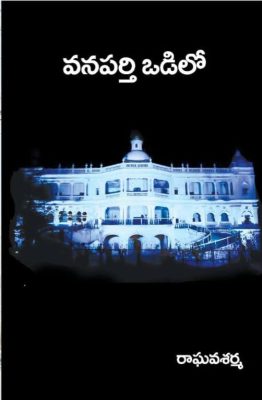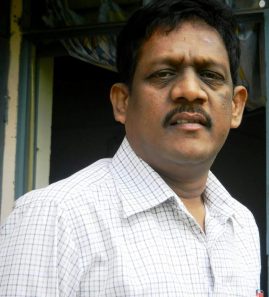
IN THE LAP OF WANAPARTHY
( AUTHORED BY SENIOR JOURNALIST RAGHAVA SARMA)
– V.Vijaya Kumar
“Wanaparthy Odilo” ( IN THE LAP OF WANAPARTHY)is indeed a series of 26 episodes that already hit many readers earlier, appearing before the readers in a compilation. It intricately weaves together the tapestry of memories, capturing the essence of a bygone era with poetic grace. Raghava Sarma, a journalist with a heart deeply entangled in the soil of Wanaparthy, embarks on a nostalgic journey through his childhood and college days, unraveling the rich history and vibrant culture of this quaint village nestled in the Mahabubnagar district of Telangana.
At the heart of the narrative lies the majestic historical palace, once the seat of the illustrious Raja Wanaparthy Dynasty, now transformed into the KrishnaDeva- Raya Polytechnic College. Despite being a descendant of this noble lineage, Raja Rameswar Rao embodies a spirit of benevolence, openly supporting the Telangana armed struggle of 1946-51. Through Sarma’s vivid recollections, the reader is transported to a time where the past resonates with the present, and every corner of Wanaparthy pulsates with life.
Sarma’s prose transcends mere storytelling, offering a captivating glimpse into the socio-economic fabric of Wanaparthy. From the humble scavengers to the resilient farmers, from the bustling street vendors to the hardworking laborers, every character is meticulously etched onto the pages of history. The landscape comes alive with the sights and sounds of so many temples and shrines like Raj Nagar Shiva temple, and its vibrant fairs, and the tranquil Peerla Gutta and Thirumalaiah Gutta and many more of their kind.
The narrative unfolds like a timeless masterpiece, with certain landmarks such as the Rama Talkies and Jagadish Talkies adding depth to the narrative. Gundu Bavi, the drinking water well, dating back to 1868 and later renovated in 1914, stands as a testament to the enduring spirit of the village steeped in historical significance, and emerges as a symbol of resilience amidst the passage of time.
Amidst the backdrop of historical intrigue, Sarma pays homage to the unsung heroes who shaped his formative years. From his primary teachers to the venerable Doctor Balakrishnaiah, and to the compassionate guru Chandra Mouli sir, each character leaves an indelible mark on the author’s psyche. Special mention is reser-ved at every turn of events in his life for his mother, Vimala Devi whose unwavering love and guidance serve as his beacon of inspiration.
The book is not merely a memoir but a profound exploration of the human experience, infused with the wisdom of hindsight and the warmth of nostalgia. Prof. G. Hara Gopal, a champion of civil rights, aptly acknowledges Sarma’s poignant portrayal of a bygone era in his foreword of who’s experiences also orchestrated with the writer as well. As a great human being who is the voice of downtrodden sections applaud the writer for his depiction of the socioeconomic phase of often neglected sections of society.
Another renowned literary legend and historian, Vakula Bharanam Ramakrishna lauds the author’s adept storytelling prowess and says, ‘there are many interesting things in this book where the author was born, grew up, saw, experienced and conveyed as a part of it. A closer look at these memories reveals that they are not limited to an individual, a family or a place. The rural social face of those days and collective life of people are depicted. It is from the foundations of rural life that cities, large societies, regions and nations flourish. Raghava Sharma’s love for nature and people are very deep. It is not possible for everyone to have such a vast memory and remember everything they have seen so fresh even after five or six decades. How deeply a man has immersed himself in his experience of the society around him and the social relations of the society is a weighting stone for him to live alive and fully. By that measure, it should be recognized that Sharma is living life to the fullest…’
The inclusion of photographs adds a visual dimension to Sarma’s narrative, allowing readers to immerse themselves fully in the enchanting world of Wana-parthy. Each image is a window to the past, capturing fleeting moments of joy, sorrow, and resilience.
In “Wanaparthy Odilo,” Raghava Sarma masterfully crafts a poetic ode to his roots, inviting readers to embark on a soul-stirring journey through the corridors of time. With every turn of the page, the village of Wanaparthy unfolds its secrets, leaving an indelible impression on the hearts and minds of all who venture into its embrace.
The final words of the eminent journalist M. Raghava Chary are breathtaking. As he rightly puts it, ‘it’s like a fillip of string in the innermost heart.’ The recollections shared by others like Vijay Kumar, Rajasekhar Raju, Nimma gadda Srinivas, Sriram Kishore, Kothapalli Ravi Babu, KL. Narasimham, Vijayasree, Gundoju Yadagiri, Aluri Venkateswara Rao and many others reveal how the memories go deeper into the heart.
In “Wanaparthy Odilo,” Raghava Sarma garu masterfully crafts a poetic ode to his roots, inviting readers to embark on a soul-stirring journey through the corridors of time. With every turn of the page, the village of Wanaparthy unfolds its secrets, leaving an indelible impression on the hearts and minds of all who venture into its embrace. Through a journalist crafted lens, Wanaparthy transcends its geographical boundaries, becoming a timeless symbol of collective memory and human resilience.
*****

A post graduate in English literature and language and in Economics. A few of my translations were published. I translated the poems of Dr. Andesri , Denchanala, Ayila Saida Chary and Urmila from Telugu to English. I write articles and reviews to magazines and news papers. To the field of poetry I am rather a new face.
